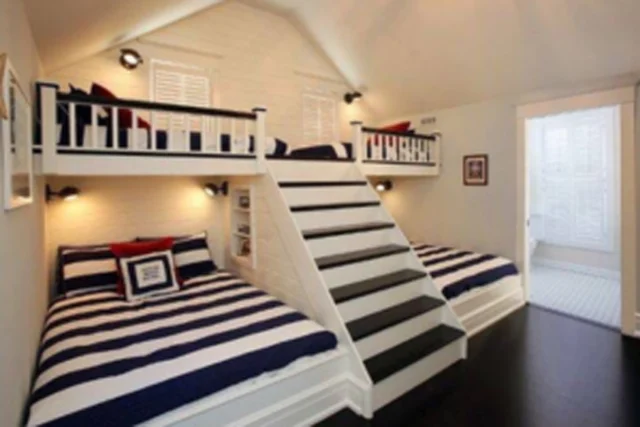I. Introduction: Why Kids Furniture Needs a Different Approach
A. How kids’ needs differ from adults in terms of design, ergonomics, and usability
Kids are not just smaller versions of adults—they have unique physical, cognitive, and emotional needs that must be reflected in their environment. Furniture for children must be appropriately scaled to their size, making it easier and safer for them to sit, reach, or store their belongings independently. Ergonomics plays a big role: desks should be at the right height to support posture during study time, chairs must support growing spines, and beds should offer comfort without being too high off the ground. Unlike adult furniture, kids’ designs must also consider ease of use, playfulness, and flexibility to adapt as they grow.
B. The role of furniture in shaping a child’s growth, creativity, and safety
Children’s surroundings directly impact their development. A well-designed environment encourages independence, sparks imagination, and supports learning. For instance, a cozy reading nook can nurture a love for books, while a themed bed might fuel storytelling and pretend play. Storage units that are easy to access teach kids responsibility by encouraging them to clean up after themselves. Just as important is safety—furniture must be free of sharp edges, toxic paints, or unstable construction. Investing in thoughtful, kid-focused furniture helps create a space where children feel secure, inspired, and free to grow.
II. Key Elements of Great Kids Furniture Designs
A. Safety-first: Rounded edges, anti-tip features, non-toxic finishes
Safety is the most critical factor in kids’ furniture design. Children are naturally curious and active, which means their surroundings need to be free of avoidable risks. Rounded corners help prevent injury during play or falls, while anti-tip mechanisms—especially on bookshelves and dressers—ensure heavy items don’t topple over. Materials and finishes must be non-toxic, low-VOC, and certified safe for children’s use. Choosing furniture that meets global safety standards not only protects kids physically but also gives parents peace of mind.
B. Space-smart: Foldable beds, multi-use desks, and stackable chairs
In today’s compact homes, maximizing space is essential—especially in kids’ rooms that double as play areas, study zones, and bedrooms. Smart furniture solutions like foldable beds or Murphy beds free up floor space during the day. Multi-use desks that function as study areas, craft tables, or storage units offer flexibility. Stackable chairs and nesting stools are great for shared spaces or siblings. These versatile pieces help make the most of every square foot without sacrificing function or fun.
C. Age-appropriate ergonomics: Sizing for toddlers, preschoolers, and pre-teens
As children grow, their physical needs change rapidly, and so should their furniture. Toddlers need low beds they can climb in and out of safely, while preschoolers benefit from activity tables and chairs that match their height. Pre-teens, on the other hand, require ergonomic study desks and chairs that support posture during longer periods of reading or homework. Adjustable or modular furniture that evolves with the child can save money in the long run and ensure comfort at every developmental stage.
III. Trending Kids Furniture Ideas in 2025
A. Safety-first: Rounded edges, anti-tip features, non-toxic finishes
Safety is the most critical factor in kids’ furniture design. Children are naturally curious and active, which means their surroundings need to be free of avoidable risks. Rounded corners help prevent injury during play or falls, while anti-tip mechanisms—especially on bookshelves and dressers—ensure heavy items don’t topple over. Materials and finishes must be non-toxic, low-VOC, and certified safe for children’s use. Choosing furniture that meets global safety standards not only protects kids physically but also gives parents peace of mind.
B. Space-smart: Foldable beds, multi-use desks, and stackable chairs
In today’s compact homes, maximizing space is essential—especially in kids’ rooms that double as play areas, study zones, and bedrooms. Smart furniture solutions like foldable beds or Murphy beds free up floor space during the day. Multi-use desks that function as study areas, craft tables, or storage units offer flexibility. Stackable chairs and nesting stools are great for shared spaces or siblings. These versatile pieces help make the most of every square foot without sacrificing function or fun.
C. Age-appropriate ergonomics: Sizing for toddlers, preschoolers, and pre-teens
As children grow, their physical needs change rapidly, and so should their furniture. Toddlers need low beds they can climb in and out of safely, while preschoolers benefit from activity tables and chairs that match their height. Pre-teens, on the other hand, require ergonomic study desks and chairs that support posture during longer periods of reading or homework. Adjustable or modular furniture that evolves with the child can save money in the long run and ensure comfort at every developmental stage.
IV. Storage Solutions That Kids Actually Use
A. Fun yet functional toy organizers
When storage is fun and easy to access, kids are more likely to use it. Brightly colored bins, open baskets, or themed toy chests not only make the room playful but also help children identify where their belongings belong. Choose organizers with soft-close lids or fabric drawers that are safe for little hands. Designs featuring animals, cartoons, or favorite themes can turn cleanup time into a game—instilling early habits of responsibility in a joyful way.
B. Under-bed storage, cubbies, and wall shelves
Making use of vertical and hidden spaces is a smart move in any kid’s room. Under-bed drawers or rolling bins can hold seasonal clothes, books, or less-used toys. Open cubbies can be used as both display and storage, perfect for showcasing action figures or stuffed animals. Wall-mounted shelves, especially when placed at a child-friendly height, free up floor space and encourage kids to organize their belongings independently. These practical setups keep the room clutter-free without sacrificing style or accessibility.
C. Label-friendly bins to encourage tidying habits
Labels—whether they’re words, pictures, or color codes—can make a big difference in teaching kids how to clean up after themselves. Using labeled bins helps kids associate items with their storage space, making the task of organizing less overwhelming. For younger children, picture labels (like a toy car image on the car bin) work best, while older kids can manage written labels. This simple strategy not only supports literacy and memory but also empowers kids to take ownership of their space.
V. Sustainable and Durable Materials for Kids Furniture
A. Why solid wood, bamboo, and engineered wood are popular choices
Parents are increasingly opting for materials that are both durable and eco-conscious. Solid wood is a classic favorite due to its strength, longevity, and timeless look. Bamboo, a fast-growing renewable resource, offers a lightweight yet sturdy alternative that’s perfect for eco-friendly homes. Engineered wood, such as plywood or MDF, when sourced responsibly, provides a more affordable option while maintaining structural integrity. These materials are less likely to crack, splinter, or wear out quickly—ideal for the wear and tear that comes with active kids.
B. Choosing eco-friendly, safe finishes and paints
Kids spend a lot of time in close contact with their furniture, which is why it’s essential to use non-toxic, low-VOC (Volatile Organic Compound) finishes. Water-based paints and natural oil polishes are safe alternatives that also reduce indoor air pollution. Look for certifications like Greenguard, FSC, or EN71 safety standards, which indicate the product meets rigorous health and environmental safety requirements. These choices don’t just protect your child’s health—they also show care for the planet.
C. Long-lasting designs that grow with the child
Sustainable design also means thinking long-term. Convertible cribs that become toddler beds, adjustable study tables, or modular storage units can evolve with your child’s changing needs. Investing in furniture that adapts to growth stages reduces the need to frequently replace items—saving money and minimizing waste. Neutral colors, sturdy craftsmanship, and timeless designs ensure that the furniture stays functional and relevant well beyond the early years.
VI. Custom vs. Modular: Which is Better for Kids?
A. Why solid wood, bamboo, and engineered wood are popular choices
Parents are increasingly opting for materials that are both durable and eco-conscious. Solid wood is a classic favorite due to its strength, longevity, and timeless look. Bamboo, a fast-growing renewable resource, offers a lightweight yet sturdy alternative that’s perfect for eco-friendly homes. Engineered wood, such as plywood or MDF, when sourced responsibly, provides a more affordable option while maintaining structural integrity. These materials are less likely to crack, splinter, or wear out quickly—ideal for the wear and tear that comes with active kids.
B. Choosing eco-friendly, safe finishes and paints
Kids spend a lot of time in close contact with their furniture, which is why it’s essential to use non-toxic, low-VOC (Volatile Organic Compound) finishes. Water-based paints and natural oil polishes are safe alternatives that also reduce indoor air pollution. Look for certifications like Greenguard, FSC, or EN71 safety standards, which indicate the product meets rigorous health and environmental safety requirements. These choices don’t just protect your child’s health—they also show care for the planet.
C. Long-lasting designs that grow with the child
Sustainable design also means thinking long-term. Convertible cribs that become toddler beds, adjustable study tables, or modular storage units can evolve with your child’s changing needs. Investing in furniture that adapts to growth stages reduces the need to frequently replace items—saving money and minimizing waste. Neutral colors, sturdy craftsmanship, and timeless designs ensure that the furniture stays functional and relevant well beyond the early years.
VII. Tips for Choosing the Right Furniture for Your Child
A. Involving your child in the decision
One of the best ways to ensure your child actually uses and enjoys their furniture is by involving them in the decision-making process. Let them choose colors, themes, or even specific pieces—within safe and practical limits. When kids feel a sense of ownership, they are more likely to take care of their space, keep it tidy, and use it meaningfully. It’s also a great opportunity to teach them about choice, budget, and functionality in a fun and engaging way.
B. Prioritizing flexibility, safety certifications, and ease of maintenance
Always look for furniture that’s versatile and safe. Flexible pieces—like extendable beds, height-adjustable desks, or stackable chairs—can grow with your child and adapt to changing needs. Prioritize products that come with child safety certifications (like EN71 or ASTM) and rounded edges, anti-tip hardware, and non-toxic finishes. And since kids can be messy, opt for easy-to-clean surfaces and durable materials that can withstand spills, scratches, and enthusiastic play.
C. Planning the room layout around activities like reading, play, and rest
Good kids’ furniture isn’t just about looks—it’s about how it supports your child’s daily rhythm. Organize the room into distinct zones: a quiet nook with soft lighting and a bookshelf for reading, an open area with accessible storage for toys and creative play, and a comfortable bed that encourages restful sleep. Designing around your child’s activities makes the space more functional and supports healthy routines—essential for their development.
VIII. Conclusion: Designing a Room That Grows with Your Child
A. Why good furniture is an investment in comfort, creativity, and development
Thoughtful kids furniture designs do more than just fill a room—they shape how your child lives, learns, and grows. Well-planned furniture supports comfort, encourages independence, and nurtures creativity from a young age. Whether it’s a cozy reading nook or a sturdy study table, investing in smart, child-focused furniture creates a space that adapts to your child’s evolving needs and milestones.
B. Encouragement to combine practicality with joy in every design
The most memorable kids furniture designs are those that blend joy with functionality. From playful colors to clever storage and multi-use layouts, good design makes everyday routines feel exciting and stress-free. By combining durability, safety, and a touch of whimsy, you’ll create a room your child will love—one that evolves with them and turns into a lifelong space of comfort and imagination.







